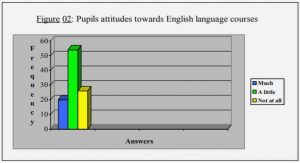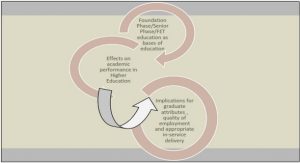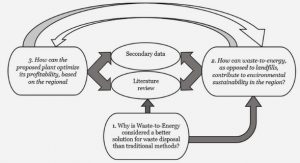Get Complete Project Material File(s) Now! »
Chapter 3 The Manufacturing Environment: Contextual Evaluation
Overview of the Manufacturing Sector
The word manufacturing is made of three Latin words manu, meaning by hand; facere meaning to make; and faber, or maker. This is to mean that manufacturing is to make products from raw materials by hand or machinery. Broadly, manufacturing is the process of transforming ideas into products and services incorporating activities from research to recycling of products. Manufacturing is a wealth creating sector and it is the base for development of the tertiary sector in most developed economies (SEDA, 2012).
Manufacturing is known as a leading edge of civilization and has been significantly contributing for economic prosperity in terms of creating a sustainable economic ecosystem, encouraging domestic and foreign investment, improving a country’s balance of payments, creating good jobs within the sector and outside, boosting a country’s intellectual capital and innovativeness (UNCTDA, 2009; Deloitte, 2013; CSA, 2012).
Manufacturing has widely been recognized as an engine of growth (Bigsten & Söderbom, 2006). Recently, however, contradictory views which challenges ‘the growth engine hypothesis’ have been advanced (Szirmai & Verspagen, 2015). Supporting the contribution of the sector for economic growth, Szirmai (2009) identified nine arguments. First, development of manufacturing sector enhances per capita income; second, productivity or value added in manufacturing is higher than in agriculture; third, manufacturing is more dynamic than other sectors; fourth, transfer of resources from manufacturing to service creates a structural change burden and it is found out that countries with higher share of manufacturing and lower share of services show faster growth than countries in which service sector is dominant; fifth, the sector provides special opportunities for capital accumulation; sixth, manufacturing sector provides better economies of scale than the service and agricultural sectors; seventh, technological advancements are concentrated in the manufacturing sector and diffused to other sectors; eighth, manufacturing has stronger linkage (backward and forward linkage with other sectors) and spillover (disembodied knowledge flow) effects; and ninth, as per capita income increases, the share of expenditure on manufactured goods increases and participation of countries in the world market increases.
Contrary to the engine of growth hypothesis, Szirmai and Verspagen (2015) found out moderate impact of the sector on the economic growth of developed countries. The study also found out that the contribution of manufacturing for economic growth is high in developing countries with a highly educated workforce. Similarly, Yoshino (2008) found out that manufacturing is a stepping stone for economic progress of low income countries. Based on empirical evidences, World Bank (2015) also strongly recommended to least developed countries like Ethiopia to reallocate their workforce and other resources from less productive agriculture to more productive manufacturing sector. Hence, manufacturing is broadly recognized as main driver of economic growth for Sub-Sahara African countries.
Manufacturing has evolved from an individual handicraft practice to an organizational activity to sophisticated networks of firms transforming raw material into finished products. The equipment used to support manufacturing has undergone a similar evolution from simple tools to systems employing complex technology combinations. The range of technologies and techniques has been growing with a goal of efficiently converting concepts into finished products and services in line with the needs and requirements of customers.
Corresponding to the advancement of machine and process technologies, the sector has also exhibited dramatic progress in management techniques and approaches. Some of the main tools advanced since 1970s include Just-in-Time (JIT) manufacturing, Concurrent Engineering (CE), Total Quality Management (TQM), and the Quick Response System. With the involvement of universities and research centers, further improvements are being carried out in the management techniques and approaches.
The sector has also exhibited changes in managerial orientations. Before the industrial revolution, manufacturers were internally oriented in which product quality and performance was defined by the craftsmen. Since 1980s, manufacturers have been reorienting themselves from craftsmen interpretation of quality and performance (internal orientation) to the interpretation of quality and performance based on customer needs and competitive situations (market orientation) (Narver & Slater, 1990; Kohli & Jaworski, 1990)
However, the technical, managerial, and philosophical developments of the sector are not uniform all over the world (Sazirmai, 2009). Manufacturing sector did not contribute to the economic growth of developing countries until 1950s and it has no contribution to the Least Developed Countries (LDCs) economy until the present time (Sazirmai, 2009; Clarke, 2012). Since 1970s US has taken the leading position in the manufacturing sector. According to United Nations (UN) report (2010), 73.3% of world share of manufacturing is owned by top ten countries, including in rank order, United States, China, Japan, Germany, Republic of Korea, Italy, UK, France, India and Mexico. Recently China is ranked first in terms of manufacturing performance (Levinson, 2015). The rest of the countries in the world have 27.7% share of manufacturing. The share of Africa is extremely low. In sub-Sahara Africa, manufacturing accounted for, on average, 13% of the GDP of countries in the region (Clarke, 2012).
In summary, the recent views of the sector indicate that 1) the contribution of manufacturing for economic growth is vital for least developed and developing countries than countries with advanced economies; 2) advancement of the sector demands improvement in policy, institutional efficiency, infrastructure, educated manpower, innovation capability, managerial competencies, and other internal and external influencers; 3) the very low share of manufacturing in the African countries economy indicates that Africa has been trading ‘nature made products’ in the world trade with little or no value addition. The following section presents overview of Sub-Sahara African manufacturing environment and review facts reported in the literature regarding the internal and external influencers that affect the development of the sector in the continent.
Manufacturing in Sub-Sahara Africa (SSA)
Sub-Sahara Africa has been identified as a region where the economy is dominated by traditional subsistence agriculture; over two-third of the population is living in rural areas; and the contribution of manufacturing to a country’s economy in the region is insignificant (Shifa, 2015; Bigsten & Söderbom, 2010). The GDP and export shares of the sector are also very low compared to its contribution in other similar regions in the world (Clarke, 2012). Most of the manufacturers in SSA are also characterized by primary commodity producers where the value addition is very small. Collier, Hoeffler and Pattillo (2001) mentioned that Africans keep a large share of their wealth (40%) outside Africa. Manufacturers in Africa also lack innovation capabilities that enable them to diversify their products and markets (Yoshino, 2008).
Recently, governments and other stakeholders in the region have been exerting enormous effort to shift towards non-farm sector, especially to the manufacturing sector (Bigsten & Söderbom, 2010). In addition, countries also recognized the need to push the horizon of operation beyond the domestic market and enhancing their global participation. Manufacturing enables countries to expand their international presence and exploit opportunities available globally. Unlike agriculture, the growth of manufacturing is not constrained by availability of land (Bigsten & Söderbom, 2010).
Although manufacturing is recognized as a key sector for the economic growth of low income countries, its development has been hampered by firm-level and macro-level influencers. Clarke (2012) and Bigsten and Söderbom (2010) identified internal and external influencers. The firm level influencers are capital intensity, educational attainment and skill levels of workers, firm organization, and management quality. External forces are factors outside of the firm including burdensome business regulations, weak governance, poor infrastructure, poorly developed financial sector, extensive corruption, less protected rule of law, and lower government efficiency.
Prior studies show that factors outside of the firm have been challenging the development of the sector more seriously. Dinh (2013) and Hailu and Tanaka (2015) identified institutional barriers including price controls, regulations on foreign trade, foreign currency regulations, tax regulations and/or high taxes, policy instability, general uncertainty regarding the costs of regulation poorly functioning legal system, and high rate of corruption and property crimes. Tybou (2003) and Clark (2012) indicated infrastructural and input supply related barriers such as small product market, limited access to manufacturing inputs, scarce human capital, poor infrastructure, thin financial market, and highly volatile macroeconomic environment. Similarly, a study by Elbadawi, Mengistae, and Zeufack (2006) revealed that poor manufacturing performance, especially export performance of manufacturers, is because of policy related factors and economic geography of African countries.
Harrison, Lin, and Xu (2012) reported comparative analysis of the performance of formal African manufacturing firms with firms in another similar region and found out that most Sub-Sahara African firms are at a disadvantageous position compared to other manufacturers in another region because of the following pitfalls:
Political and institutional pitfalls- ethnic fractionalization, property right protection, and armed conflict. Party monopoly induces fear of expropriation among entrepreneurs, which again encourage entrepreneurs to invest in low-productive businesses.
Business environment- factors in this category include poor institutional performance (corruption and expropriation by government officials and criminals), lack of labor market flexibility, and lack of competitive product market.
Access to finance -access to bank finance and other informal sources is limited Countries in SSA have been trying to reduce barriers and stimulate the growth of the manufacturing sector by introducing series of policies (Bigsten & Söderbom, 2010). In 1960s, the dominant policy was import substitution. This policy was developed after independence and introduced basically to protect firms at their initial level of learning. However, according to critics, the policy discourages innovation and productivity as domestic firms did not come under pressure because of guaranteed domestic market. In 1980s and 1990s, structural adjustment policies replace import substitutions. Based on this, trade protection was reduced and currencies are devalued. However, structural adjustment program has limitation in terms of exposing weaker companies to global competition.
The literature shows competing views regarding the consequence of reducing protection and then promoting openness. In the one hand, openness is viewed as a source of success as it improves efficiency by reducing managerial slack and using inputs more efficiently; it encourages full exploitation of economies of scale; improve industry productivity through resource reallocation; and improve access to technologies and new methods of operations (Clark, 2012). On the other hand, openness is viewed as distracter of infant industries in poor countries because of serious foreign competition and hence such industries should be protected (Umoh & Effiong, 2013).
Recently, policy makers are trying to look for ways of participating in the global market by reducing the negative consequences of openness and being closed. Based on this, researchers suggested that Africa can gain sustainable competitive advantage in light manufacturing (Dinh, 2013). Light manufacturing is appropriate for countries in Sub-Sahara Africa because first, the direction is proved to be fruitful in economically successful developing countries such as Mauritius, Vietnam, and China; second, light manufacturing is labor intensive and it allows poor countries to utilize the abundant labor available; and third, light manufacturing save foreign exchange, create rewarding jobs, and develop technical and managerial skills (Dinh, 2013).
There is a huge potential for Africa to develop light manufacturing and gain unique position in the competitive environment for various reasons (Dinh, 2013). Many countries in Africa have advantages in low-wage labor, abundant natural resources, privileged access to high income markets (such as the AGOA arrangement), and sufficiently large local and regional market. Emerging light manufacturers can acquire and develop technical and managerial capabilities (quick-response system, high volume production, and quality control) by developing and implementing strategy to utilize the local and regional markets.
Next to formulating proper policy and reducing institutional obstacles is improving the competitiveness of firms by strengthening their internal capabilities. Manufacturing firms in Africa are extremely weak in terms of resource availability and capabilities. Firms lack capital equipment, finance, skills of individual employees, and talents of management; and they also lack management capacity to use resources in a way that achieves goals and objectives.
Besides the initiative to improve policies and institutional arrangements, government and other stakeholders are providing assistance to strengthen the resource and managerial capacity of firms. Currently, for example, firms are encouraged by the government to implement modern management approaches (such as Business Process Reengineering and Kaizen) that have been used by industrialized nations (Negussie, Lemma & Assefa, 2013; Desta, 2013). Hence, such efforts need to be backed by scientific investigations. In this regard, empirical investigations should explore the current management orientations and approaches of firms and identification of appropriate managerial models that facilitate future competitiveness of manufacturers.
In summary, the above discussion reveals that 1) though policy intervention is mandatory to reduce institutional barriers, it cannot be productive unless supported by firm-level managerial capabilities as well as capabilities in terms of input availability, access to industrial land, access to finance, trade logistics, entrepreneurial skills, and worker skills (Dinh, 2013) ; 2) the current trend of globalization creates opportunity to strengthen manufacturing firms in terms of organizational assets (human, financial, marketing, systems, and physical assets) and organizational competencies (strategic, functional, operational, individual, and team competencies). Hence, proper organizational orientations facilitate the identification and utilization of such opportunities.
Manufacturing in Ethiopia
Country Overview
Ethiopia is the second populist country in Sub-Sahara Africa with a total population of 94.1 million, population growth rate of 2.5%, and population below the age of 14 is 44.4% (Word Bank, 2015). The country covers an area of 1.14 million square kilometers and has favorable climate, natural resources and historical places that show miraculous ancient civilizations. Ethiopia is a land locked country which shares borders with Sudan in the west and North-west, South Sudan in the west, Kenya in the south, Somalia in the east and southeast, Eritrea in the North and Djibouti in the east.
Ethiopia follows ethnic-based federalist political structure which assumes that ethnic groups can exercise political power in administering their respective regions and use own language and develop own culture. Based on this, the country is politically structured into 9 regional states and 2 city administrations. Every regional state has its own policy, strategy, and structure to attract investment and promote enterprise development.
Despite Ethiopia is one of the oldest centers of civilization and cradle of mankind, the country didn’t sustain such remarkable achievements. Rather, the country has been classified as one of the poorest countries in the world characterized by frequent famine, acute food shortage, extreme poverty, and poor quality of living (World Bank, 2015).
The economy of the country is dominated by agriculture and least value adding service activities. The share of employment of agriculture (77.3% in 2013/14) was the largest share compared to manufacturing and service sectors. The shares of the three sectors to GDP in 2013/14 are 40.2% (agriculture), 45.5% (services), and 14.3% (industry); the share of manufacturing within the industry sector was only 4.4% (World Bank, 2015).
TABLE OF CONTENTS
Page
Declaration of Originality
Abstract
Acknowledgement
Table of Contents
List of Tables
List of Figures
List of Abbreviations
CHAPTER 1 INTRODUCTION AND BACKGROUND INFORMATION
1.1. Background of The Study
1.2. Problem Statement
1.3. Aim and Objectives
1.4. Scope of the Study
1.5. Methodology Summary
1.6. Rationale of the Study
1.7. Significance of the Study
1.8. Key Assumptions
1.9. Limitations of the Study
1.10. Synopsis of Chapters
1.11. Summary
1.12. Operational Definitions of Concepts and Constructs
CHAPTER 2 THEORY AND LITERATURE REVIEW
2.1. Introduction
2.2. Theories of Competitive Advantage
2.3. Strategic Orientations as Dynamic Capabilities
2.4. Market Orientation
2.5. Innovation
2.6. Marketing Capabilities
2.7. Innovation, Market Orientation and Marketing Capabilities Interactions
2.8. Antecedents of Strategic Orientations and Marketing Capabilities
2.9. Competitiveness
2.10. Conceptual Framework
2.11. Summary
CHAPTER 3THE MANUFACTURING ENVIRONMENT: CONTEXTUAL EVALUATION
3.1. Overview of the Manufacturing Sector
3.2. Manufacturing in Sub-Sahara Africa (SSA)
3.3. Manufacturing in Ethiopia
3.4. Summary
CHAPTER 4 RESEARCH METHODOLOGY
4.1. Introduction
4.2. Research Paradigm
4.3. Research Design
4.4. Population and Unit of Analysis
4.5. Sample and Sampling Methods
4.6. Data Collection Methods and Procedures
4.7. Data Analysis Procedure
4.8. Summary
CHAPTER 5 DATA PRESENTATION AND ANALYSIS
5.1. Introduction
5.2. Aim of the Study, Research Question and the Conceptual Model
5.3. Data Collection, Examination and Preparation
5.4. Descriptive Statistics
5.5. Assessment of the Measurement Model
CHAPTER 6 DISCUSSION OF RESEARCH FINDINGS
6.1. Introduction
6.2. Discussion of Hypotheses Testing Results
6.3. Summary
CHAPTER 7 SUMMARY OF FINDINGS, IMPLICATIONS, AND CONTRIBUTIONS
7.1. Introduction
7.2. Summary of Key Findings-Research Questions Revisited
7.3. Recommendations
7.4. Contributions of the Study
REFERENCES
GET THE COMPLETE PROJECT






